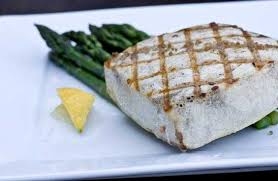The swordfish is one of the meatiest
salt-water fish. Swordfish steaks have a dense texture and a mildly sweet
flavor, and that makes it a restaurant favorite. Grilled or fried fresh swordfish with just a
few herbs is hugely popular. Despite the
ease of frying or grilling swordfish, French chefs often choose recipes that
allow them to show more of their skills.
If you see the uncooked swordfish in
a fishmongers or supermarket, you may note that from time to time they come in
different colors, from pale ivory to orange. However, the color does not
reflect the quality or taste instead; it reflects the area where the fish are
caught and what they ate for breakfast, lunch, and dinner.
A serving of salmon and swordfish
www.flickr.com/photos/gpeters/3350273535/
Swordfish on French Menus:
Carpaccio d'Espadon à l'Huile de Sésame, Citron Vert et Ses Œufs de Lompe - A swordfish Carpaccio prepared with sesame oil, lime, and lumpfish caviar. Lumpfish are caught for their roe, and after their roe has been died red or black it is mostly sold as “Lump Fish Caviar.” In France that will be downgraded to œufs de-lump, lumpfish roe, as the word caviar is legally restricted to the sturgeon eggs.
Espadon en Daube - A swordfish stew; a fishy take on the traditional Provençal Daube, a meat and or game stew made with red wine. Here, in this swordfish recipe, the white wine will replace the red, and butter along with crème fraiche will be part of the recipe..
Grilled swordfish with fresh green asparagus.
Espadon Fume – Smoked swordfish; when thinly sliced and served cold as an entrée is a real treat. I have enjoyed, more than once, a mixed platter of cold-smoked salmon and cold-smoked swordfish; they provide an excellent contrast in taste and texture; if it’s on the menu go for it.
Swordfish on sale in the market.
www.flickr.com/photos/freecat/67077021/
Espadon Mi-Cuit Compotée de Tomates, Olives, Anchois, Pignons de Pin et Câpres – A swordfish steak just seared on each side. The swordfish is accompanied by stewed tomatoes, prepared with olives, anchovies, pine nuts, and capers. There is no better way to enjoy a tuna steak when it is just seared on the outside and uncooked on the inside; this creates two beautiful tastes and textures. (In the UK and North America, a compote is stewed fruits served as a dessert. In France, a compote may also be a stewed fruit dessert, but, just as often, as in this menu listing, it is a dish of stewed vegetables).
Pavé d'Espadon à la Plancha, Pipérade –- A thick cut of swordfish, fried with olive oil on the thick flat metal plate that is called a Basque plancha. The pipérade that accompanies the swordfish is a traditional Basque dish made with the Basque region's famous red peppers, the Piment d'Espelette AOP. In many Basque recipes, these unique red peppers will be fried with onions, green peppers, tomatoes, and garlic. In France, it is unlikely that the pipérade will be very very spicy; however, chefs do have their own ideas, so if you are worried ask.
Tartare d'Espadon à la Poire, Avocat et Éclats de Gingembre – Swordfish Tatar, prepared with pears and avocado and flavored with the glow of ginger.
The swordfish on your menu.
In mainland France, the swordfish will be fresh from the Atlantic or the Mediterranean. While the largest European swordfish may reach over 4 meters (13’) from the tip of the sword to the tip of its tail, the local fishermen and women will be catching fish that reach up two meters (6.5’), and that still means one large fish weighing around 120 kilos (265 lbs); just about enough for two steaks with a bit left over for the cat :-)
The swordfish and its sword.
The sword of the swordfish is not used to duel with other swordfish or to spear its lunch; instead, it is used as a club when hunting. When the swordfish swim into a school of fish, it will wave its sword from side to side and stun or wound the smaller fish; then it turns around and eats them.
The swordfish in the languages of France’s neighbors:
(Catalan - peix espasa), (Dutch - zwaardvis), (German - schwertfisch), (Italian - pesce spada), (Spanish - pez espada), (Latin - xiphias gladius).
Behind the French Menu
------------------------------------------
Behind the French Menu
by
Bryan G. Newman
behindthefrenchmenu@gmail.com
Copyright 2010, 2013, 2018.2019.
For information on
the unpublished book behind this blog, contact Bryan Newman.
at
--------------------------------
Searching for the
meaning of words, names or phrases
on
French menus?
Just add the word, words, or phrase that
you are searching for to the words "Behind the French Menu" (best
when including the inverted commas), and search with Google, Bing, or
DuckDuckGO. Behind the French Menu’s links, include hundreds
of words, names, and phrases that are seen on French menus. There are over 450
articles that include over 4,000 French dishes with English translations and
explanations.
Connected Posts:
Tomate – Tomato. France’s Greatest Tomato, the Tomate de Marmande AOC. The Tomato in French Cuisine.














